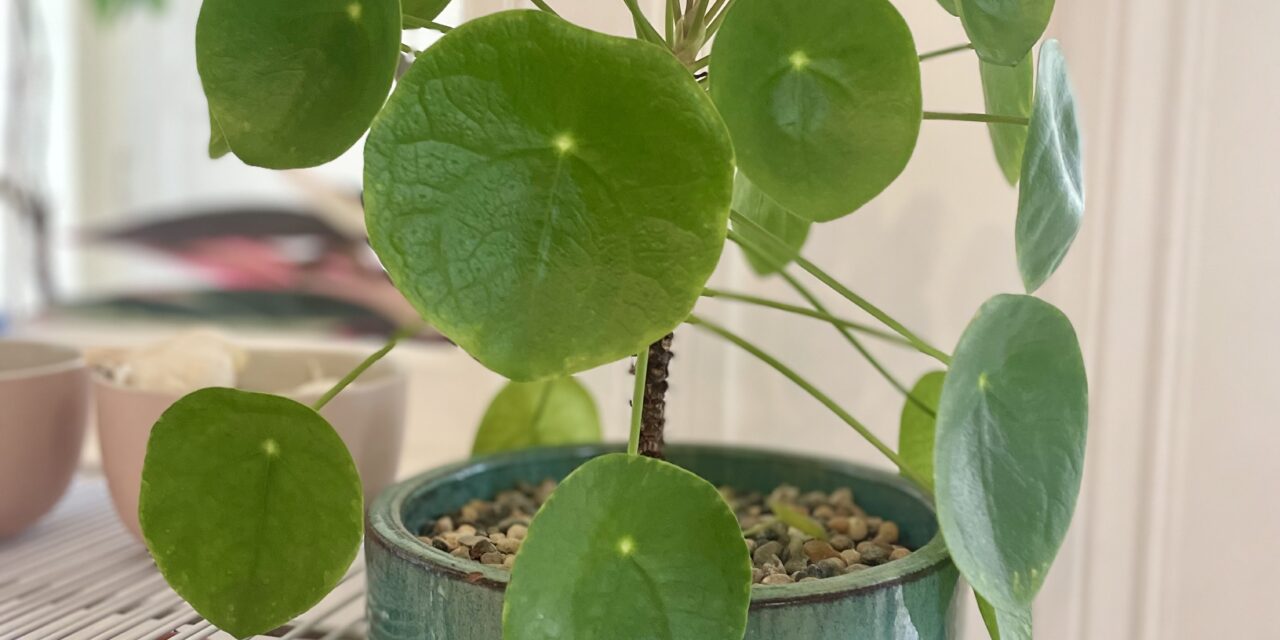The Chinese Friendship Plant (Pilea peperomioides), or “Pilea,” I bought five years ago has become seven separate, full-grown plants that I’ve given to six very happy friends. This joyful, low-maintenance plant completely lives up to its name. Its lilypad-like leaves remind me a bit of Shrek’s ears. It’s fun and has a ton of character. It’s also incredibly easy to propagate which, to me, always feels like I’ve scored some sort of lucky “2 for the price of 1” deal. Here’s what I’ve learned in the past five years of growing a family of thriving Pilea plants:

1. They can be quite light and water sensitive.
While I’ve generally found my Pilea to be very low-maintenance, it took a little finessing early on to find the perfect spot in my apartment where its leaves weren’t burning and it wasn’t becoming too dry. The good news is that if you pay attention, its leaves will tell you everything you need to know. When they’re deep green, shiny, and convex, the plant is typically healthy and happy. If its leaves start to look bleached, start forming yellow spots, or become droopy and convex, it’s time to move your plant to a different spot in your home to see if it’s happier there. The sweet spots for me have been about 6 ft. away from a south-facing window and a full, saturated watering every couple weeks.

2. This is the perfect starter plant if you’ve never propagated a plant before.
When it’s getting the water and light it needs, a Pilea will grow explosively. When it does, you’ll start to notice offshoots from its main brown stem, typically near the base of the plant. You can cut these new, brown stems anywhere below a leaf node and pop it in a shallow container of water. Avoid submerging the cutting’s leaves at all, as this will cause them to rot. Place the container on a bright windowsill (I’ve used a north-facing windowsill with great success) and roots will start to grow over 1-2 weeks. Once those roots are about an inch long, plant your new Pilea in a small pot in soil and watch it thrive! I’ve tried and failed to propagate dozens of other plants, but my Pilea’s cuttings have taken to new pots every time.

3. Prune, prune, prune.
Every part of a plant requires it to expend energy to maintain, so if you notice a leaf start to turn yellow or brown, it’s best to proactively remove it. I can always tell when a leaf has died by tapping it at the base of its stem. If it detaches easily, I pinch it off. If it stays solidly attached to the main stem, I’ll leave the leaf alone.

4. Take early steps to avoid pests.
Because the Pilea is okay in slightly lower light and seems to like consistent, low moisture, it can be pest-prone. I’ve struggled with fungus gnats in the past and have found that the best way to prevent them is by covering the surface of my Pilea’s soil with a layer of small pebbles that prevent adult gnats from accessing its soil. There are a ton of beautiful options for inexpensive, small planter pebbles, so you’ll be beautifying your home in the process.

5. If your “bright, indirect light” windows are full, this may be the perfect option for you.
Even in a large apartment with lots of windows, I tend to run out of space in my east- and west-facing windows. While most online sources will tell you that the Pilea thrives in bright, indirect light, I’ve actually found that mine is happiest when it’s about 6 ft. away from a south-facing window in a spot that stays shaded for most of the day. All this means is that I water it slightly less often than I might otherwise.
The Pilea is a spunky, low-maintenance plant that will liven up any space. Its coin-shaped leaves are a refreshing deviation from a typical houseplant. I’ve received many compliments on my Pilea, and the best thing is that every friend who has complimented it has received a baby Pilea of their own! There are few things better than a low-maintenance, good-looking plant that also strengthens friendships and forms new ones. If you’re looking for a delightful addition to your space, the Chinese Friendship Plant is for you.




